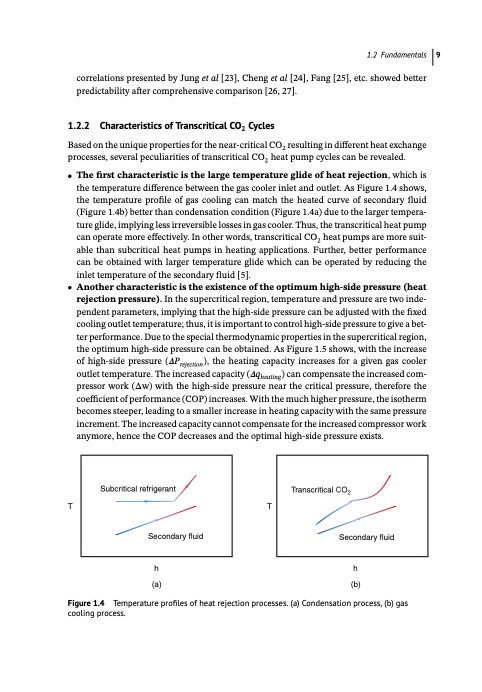
PDF Publication Title:
Text from PDF Page: 025
1.2 Fundamentals 9 correlations presented by Jung et al [23], Cheng et al [24], Fang [25], etc. showed better predictability after comprehensive comparison [26, 27]. 1.2.2 Characteristics of Transcritical CO2 Cycles Based on the unique properties for the near-critical CO2 resulting in different heat exchange processes, several peculiarities of transcritical CO2 heat pump cycles can be revealed. ● The first characteristic is the large temperature glide of heat rejection, which is the temperature difference between the gas cooler inlet and outlet. As Figure 1.4 shows, the temperature profile of gas cooling can match the heated curve of secondary fluid (Figure 1.4b) better than condensation condition (Figure 1.4a) due to the larger tempera- ture glide, implying less irreversible losses in gas cooler. Thus, the transcritical heat pump can operate more effectively. In other words, transcritical CO2 heat pumps are more suit- able than subcritical heat pumps in heating applications. Further, better performance can be obtained with larger temperature glide which can be operated by reducing the inlet temperature of the secondary fluid [5]. ● Another characteristic is the existence of the optimum high-side pressure (heat rejection pressure). In the supercritical region, temperature and pressure are two inde- pendent parameters, implying that the high-side pressure can be adjusted with the fixed cooling outlet temperature; thus, it is important to control high-side pressure to give a bet- ter performance. Due to the special thermodynamic properties in the supercritical region, the optimum high-side pressure can be obtained. As Figure 1.5 shows, with the increase of high-side pressure (𝛥Prejection), the heating capacity increases for a given gas cooler outlet temperature. The increased capacity (𝛥qheating ) can compensate the increased com- pressor work (Δw) with the high-side pressure near the critical pressure, therefore the coefficient of performance (COP) increases. With the much higher pressure, the isotherm becomes steeper, leading to a smaller increase in heating capacity with the same pressure increment. The increased capacity cannot compensate for the increased compressor work anymore, hence the COP decreases and the optimal high-side pressure exists. Subcritical refrigerant TT Secondary fluid Transcritical CO2 Secondary fluid hh (a) (b) Figure 1.4 Temperature profiles of heat rejection processes. (a) Condensation process, (b) gas cooling process.PDF Image | What is a heat pump

PDF Search Title:
What is a heat pumpOriginal File Name Searched:
L-G-0016174002-0052376109.pdfDIY PDF Search: Google It | Yahoo | Bing
CO2 Organic Rankine Cycle Experimenter Platform The supercritical CO2 phase change system is both a heat pump and organic rankine cycle which can be used for those purposes and as a supercritical extractor for advanced subcritical and supercritical extraction technology. Uses include producing nanoparticles, precious metal CO2 extraction, lithium battery recycling, and other applications... More Info
Heat Pumps CO2 ORC Heat Pump System Platform More Info
| CONTACT TEL: 608-238-6001 Email: greg@infinityturbine.com | RSS | AMP |